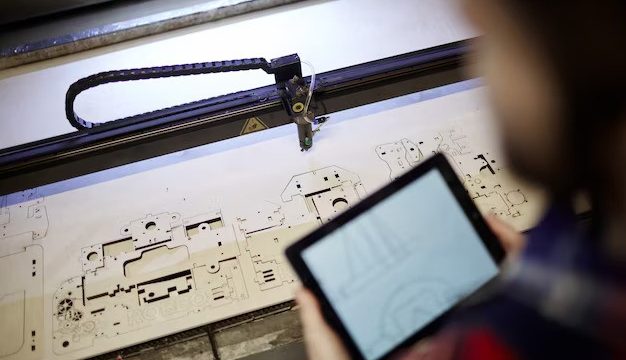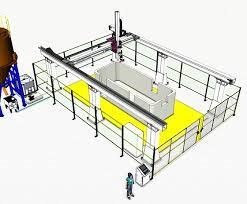3D Printing Technology in Intelligent Construction
3D printing can create complex building components quickly and cost-effectively. It’s used for prototypes, molds, and even full-scale construction. 3D printing, also known as additive manufacturing, is revolutionizing the construction industry by enabling intelligent construction projects.


Key Features of 3D Printing in Intelligent Construction:
- Customization and Design Freedom:
- 3D printing allows for the creation of highly customized building components and structures.
- Architects and designers can explore intricate and complex designs that were previously difficult or impossible to achieve with traditional construction methods.
- Rapid Prototyping:
- 3D printing enables the quick production of scale models and prototypes, facilitating design validation and iteration.
- Architects and engineers can experiment with different design ideas before finalizing plans.
- Construction Materials:
- Various construction materials, including concrete, plastics, metals, and even bio-based materials, can be used in 3D printing.
- This flexibility allows for a wide range of applications, from creating concrete walls to building components made of recycled plastics.
- Reduced Waste:
- Additive manufacturing is an inherently sustainable process as it produces minimal waste.
- 3D printing technology allows for precise material deposition, reducing the need for excess material and minimizing construction site waste.
- Speed and Efficiency:
- 3D printers can work around the clock, 24/7, potentially speeding up construction projects significantly.
- It reduces the labor-intensive aspects of traditional construction and enables rapid construction, particularly for repetitive tasks.
Types of 3D printing Products and Applications used in Intelligent Construction:
- Contour Crafting: Contour Crafting is a large-scale 3D printing technology designed specifically for construction. It can print walls, floors, and other structural elements with high precision and speed.
- Apis Cor: Apis Cor is a company that has developed a mobile 3D printer capable of constructing small to medium-sized buildings on-site. Their technology is notable for its portability and speed.
- ICON: ICON is known for its Vulcan 3D printer, which is designed for construction purposes. It has been used to 3D print homes and structures in various locations.
- Concrete 3D printers: Concrete 3D printers are a specific subset of 3D printing technology used in intelligent construction. These printers are designed to create three-dimensional structures and building components using concrete or other cementitious materials.
- Architectural 3DModel: Architectural 3D modeling plays a crucial role in the use of 3D printing technology in intelligent construction. These models serve as the digital blueprints for 3D printers to create physical structures and components.


Benefits of Using 3D Printing in Intelligent Construction:
- Design Freedom and Customization: 3D printing allows for the creation of highly customized and intricate designs, enabling architects and designers to explore new possibilities and unique architectural forms.
- Rapid Prototyping: 3D printing facilitates quick and cost-effective prototyping, enabling designers and engineers to test and refine their ideas before construction begins, reducing errors and rework.
- Speed and Efficiency: Additive manufacturing can significantly reduce construction timelines by automating and expediting the building process. This can lead to faster project completion and reduced labor costs.
- Reduced Waste: 3D printing generates minimal construction waste as it only uses the materials necessary for the project. This reduces material costs and contributes to sustainability goals.
- Sustainable Practices: 3D printing can use recycled materials and more environmentally friendly construction materials, contributing to sustainable construction practices and reducing the industry’s carbon footprint.
Applications of 3D Printing in Intelligent Construction:
- Custom Architectural Elements: 3D printing enables the creation of intricate and customized architectural components, such as facades, cladding, and decorative features. These unique designs can enhance the aesthetic appeal of buildings.
- Concrete Structures: Large-scale 3D printers can create entire concrete structures, including walls, columns, and beams. This technology streamlines the construction process and reduces labor requirements.
- Modular Construction: 3D printing can produce modular building components, which can be assembled quickly and efficiently on-site. This approach accelerates construction timelines and reduces costs.
- Bridge Construction: 3D printing is used to create bridge components, such as girders and parapets. It allows for the customization of bridge designs to suit specific locations and requirements.
- Building Components: Various building components, including stairs, balustrades, and partitions, can be 3D printed with precision and customization.
Case Study of 3D Printing in Intelligent Construction:
- Problem: Limited Speed of Traditional Construction
- Solution: 3D printing can significantly speed up the construction process. For example, in Dubai, the “Office of the Future,” the world’s first 3D-printed office building, was constructed in just 17 days, significantly reducing construction time compared to traditional methods.
- Problem: Labor Shortages in Construction
- Solution: 3D printing can reduce the need for a large construction workforce. In China, the Winsun company used 3D printing to create ten houses in a single day, showcasing the potential for automation to address labor shortages.
- Problem: Cost Overruns and Budget Constraints
- Solution: 3D printing can lower construction costs. In Nantes, France, the “Yhnova” project demonstrated how 3D printing reduced the cost of building a social housing unit by 20% compared to conventional construction.